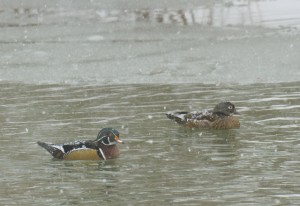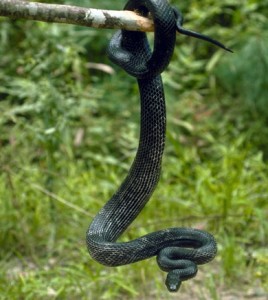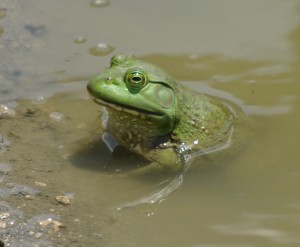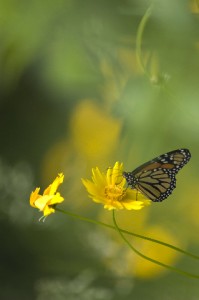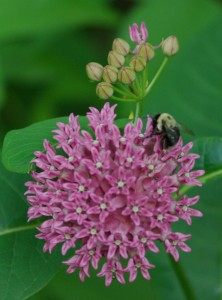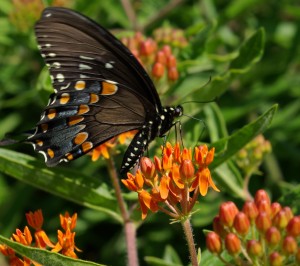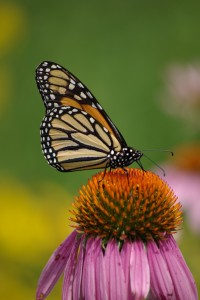The View from on High: Eagles to Milkweeds
From high on the bluff’s clifftops, such as at Fults Hill Prairie Nature Preserve or Eagle Cliff/Miles Cemetery, observers have an entirely new perspective and ability to literally look down on soaring birds, perhaps spotting an eaglet in its awkward initial attempt at flight. The eaglets, which hatched in January or February, fledge after three months in the nests, and begin flight training over the American Bottoms in June. They reman under the continued care of their parents for several years.
American Bald Eagles are our largest and longest-lived raptors, with an eight-foot wing span and estimated life span of 30 years. Their high-pitched, squeaky calls, similar to chalk scratching a blackboard, are frequent and given at all seasons. Eagles are monogamous, mating for life. They nest along the Mississippi River’s flood ways. Primarily fish eaters, they are opportunistic and will steal prey from other birds, and keep watchful eyes on turkey vultures to heist their carrion food. Immature eagles do not attain the distinctive white head and tail combined with dark brown body color of an adult until their fifth year. At that time, they establish their own territories and seek mates.
Still listed as a Threatened Species in the lower 48 states, American Bald Eagle populations have steadily grown. The Illinois population of 5 breeding pairs in 1982 had reached 43 pairs by 1999 and has continued to increase; three to four pairs are now in Monroe and Randolph Counties. When the bald eagle became our nation’s symbol in 1782 — a declaration deplored by Benjamin Franklin who had suggested the Wild Turkey as a better mascot — the nationwide population was estimated at over 100,000 breeding pairs of bald eagles.
Not as fierce and powerful in appearance, but equally as spectacular, our area’s beautiful resident Wood Ducks also are taking care of family business in June. Wood duck’s webby feet have claws, enabling them to perch in trees. They nest in holes drilled by woodpeckers in trees that often are located well away from water. After egg incubation, the male (or drake) usually abandons the female. As she continues to care for the hatchlings, he congregates and socializes with other drakes at “loafing sites” in our sinkhole ponds or in wetlands along the bottoms. Female wood ducks sometimes indulge in a practice called “dump nesting,” especially in areas where nesting sites are few but the duck population is large. In these cases two or more females lay eggs in one nest, with the intruders waiting until the host bird has left her site for feeding. A single hen’s nest of 10-15 eggs can then have as many as 40 eggs, which the hapless original nester then cares for through incubation and fledging chores. While egg laying and incubation take nearly a month, the nestling phase lasts only 24 hours.
In June, mother wood ducks encourage their ducklings to leave their nests even though the day-old chicks still cannot fly. As the hen calls from the ground, the ducklings scratch their way up to the cavity opening and spring out, free-diving as far as 60 feet to the ground. When the last one falls out, the journey overland begins as they form a long line scurrying after their mother as she walks them to the nearest water — sometimes at a distance of a mile or more. The journey can be perilous, with predators taking stragglers or even an entire brood. Once at water, the vulnerable ducklings spend about a month surface feeding and growing their flight feathers as their mother continues to care for the brood. Perhaps only a third or a half of the ducklings manage to survive to test their flight skills.
One of the wood ducklings’ chief predators are black rat snakes. Like garter
snakes, the black rat snake is very common in the bluffs. Adults are three to six feet in length and have blotchy black backs and white bellies. Black rat snakes mate in April; females lay 10 to 20 eggs in May through July, which hatch in late summer into fall. The foot-long hatchlings don’t look at all like the adults, but are grayish-tan with brownish blotches.
Black rat snakes are arboreal constrictors and very keen hunters. They principally feed on hatchling birds, birds’ eggs, mice and voles, and are a tremendously valuable, effective and beneficial natural rodent control. Their tongues are their primary sensing organs, tasting the air to smell prey. Stupendous climbers, they can be found high in trees and high in barns as they seek birds’ and mice nests. In winter, black rat snakes den in old mammal burrows, rock outcroppings, old wells or cisterns, and in tree stumps. They will den with other snakes, including copperheads and rattlesnakes, a practice that led early settlers to name them “pilot” snakes in the belief that black rat snakes would show rattlesnakes the way to a safe winter den.
An occasional competitor of the black rat snake for wood duck hatchlings and voles, is the Bull Frog, Illinois’ largest frog at up to six inches long. These common residents of the bluff’s sink hole ponds also breed in June. Male bull frogs are now calling their deep bass “jug-a-rum” as an advertisement of availability for mating. Female bull frogs are attracted to the male who calls
loudest and longest and will enter his territory. She lays massive sheets of eggs, up to 20,000, which appear like black dots in a cloudy gel, on the water’s surface. The male then fertilizes the eggs which hatch into tadpoles in four to five days. Tadpoles grow for a year before metamorphosing into young froglets which do not reach mature size for another two to three years. Bullfrogs are classed as a game animal in Illinois and have both bag limits and allowed taking seasons for their protection. Native to much of Eastern North America, they have been introduced in Western states and other countries as a food source.
Adult bull frogs will eat anything they can get their mouths around. In addition to eating insects and other amphibians, bull frogs have been known to take wood ducklings and even non-water birds, such as small songbirds, from pond edges. In Randolph County, a bull frog was reported to have swallowed a vole.
So, what on earth IS a vole? These food morsels of choice for many species can be found throughout Canada and the U.S. wherever there is good grass cover. Voles are small rodents, with short, little ears that are nearly concealed by hair, short tails and black, beady eyes. There are two species of voles in Southwest Illinois: Prairie Vole and Woodland (or Pine) Vole. Both are about four inches long, have one-inch tails and long grayish-brown fur. Many gardeners mistakenly blame moles for destroying plants; but the real culprits are voles who happily travel along the underground tunnels moles make as they search for earthworms and grubs. The voles eat plant roots and bulbs. Voles are very prolific: prairie voles have litters of three to four young three to four times per year and females begin to breed when they are one month old. They are a very important food source for mammals such as foxes and coyotes, and hawks, owls, snakes, and at least one Randolph County bull frog.
Monarch butterflies are on the wing throughout Illinois and much of the eastern
U.S. by June. Their long, generational flight from wintering areas in Mexico brings them to Illinois by April. They often produce three broods here, with adults from the last brood maturing in September and beginning the long journey back south. The State Insect of Illinois (as well as six additional states), monarchs are easily recognized, found in nearly all areas, and are easily approached and viewed. Monarch numbers have varied over the years with recent declines noted. The cause of population reduction has been attributed to timbering and development pressure on their wintering grounds and to a lack of larval host plants in their summer breeding areas.
The familiar story of monarch and milkweed is well known. Female monarchs lay eggs on milkweed plants and the caterpillars that hatch eat milkweed leaves from which they also absorb chemicals. These alkaloid chemicals remain in the adult butterfly, making them distasteful and toxic to birds. Once common throughout the U.S., milkweed plants have become — at least from a monarch’s perspective — fewer and farther apart as meadows and marshes, roadside “waste” areas, and field hedgerows disappear.
Thirteen species of milkweed — members of the Asclepias plant genus — grow in Monroe, St. Clair, and Randolph Counties. The plants exude a milky, sticky sap and have flowers in clusters with a complicated structure of five petals and a hood. This structure can trap insects and bees, as the hood can catch hold of
a leg or probing proboscis, temporarily trapping the insect in place. This capture can be of advantage to a viewer or photographer who may think a butterfly unusually cooperative, but can be a deadly trap for a honeybee caught by a waiting and watchful yellow-jacket on the lookout for a free meal. Milkweed flowers are nectaring magnets for many butterfly species as well as moths, flies, bees and wasps, which are the only insects that actually pollinate the milkweed flowers and which have adapted to avoid the flower traps.
The aptly named butterfly weed, Asclepias tuberosa, begins blooming in late May and continues through August, when the bright yellow and orange flowers give way to seed pods that then dry and burst open sending seeds parachuting on downy white silk. Early settlers knew this plant as “pleurisy root” and brewed a root tea for bronchial and lung ailments. Other medicinal uses for
milkweeds — named after the Greek god of healing, Asklepios — included treatments for dysentery, bruises and cuts, as well as a laxative and a treatment for syphilis. In fact, so many claims were made for milkweeds’ medicinal properties that it was the cure-all and “wonder drug” of the 18th and 19th centuries.
While few of us drink decoctions of milkweed root today, another June-blooming bluffs plant — Echinacea –has received attention in our time as a potential immune system booster. More commonly known as coneflowers, or even coneheads, pale
prairie coneflowers and purple coneflowers light up glades and prairies with their pink petals and faintly honey-like scent. The unwary flower sniffer quickly learns the truth of the Greek root of the plant’s scientific name. The prickly scales on the cone tops are just like an echinos , a hedgehog. Like milkweeds, coneflowers are nectaring magnets for many butterflies, moths, bees and wasps. Purple coneflowers grow in our many glades and along roadsides. Pale prairie coneflowers are at their best high on the hill prairies of the bluffs, where someone might also glimpse an eagle.
Clifftop, a local nonprofit organization, is focused on preserving and protecting area bluff lands.
A version of this article appeared in the June 6 2007 edition of the Monroe County Clarion.
© 2007 all content rights reserved, Clifftop NFP.
Comments are currently closed.


